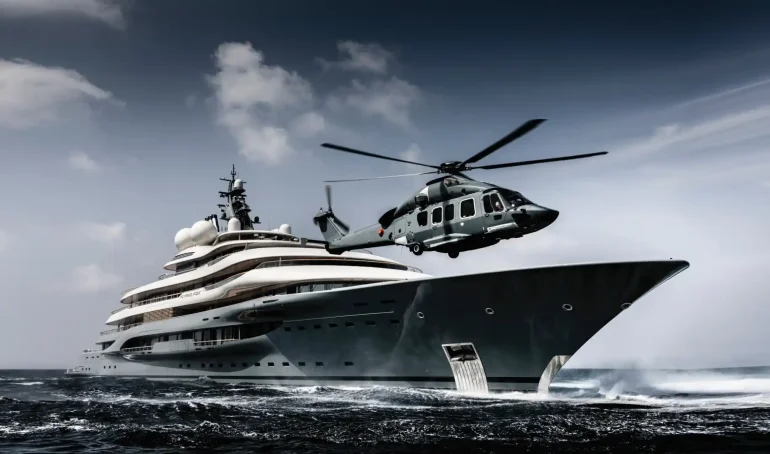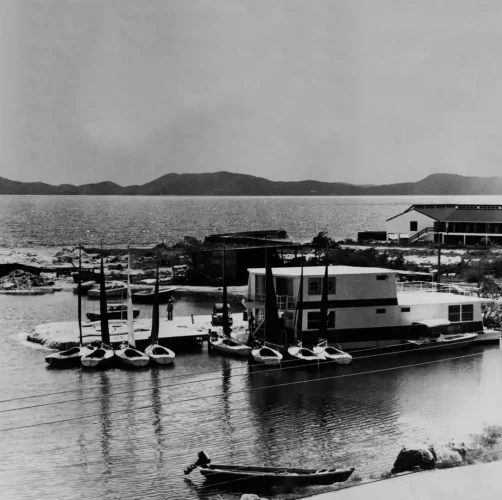Broach? Ouch! Avoiding that Downwind Disaster – Sailors love their breeze, for where would they be without it? It is the very engine that drives the boat. Predicting it, gauging its strength, controlling its effect on the sails and learning to avoid its wrath should the calculations be wrong, this is the very essence of sailing. Awareness of the breeze and its strength and direction are essential to the sailor and become second nature as experience builds. Sometimes though, whether through carelessness or bad timing, the careful choreography can come undone—with unfortunate results.
Some readers may remember an incident last winter when a charter yacht under full sail was struck by a squall off Peter Island and went down in a matter of minutes. The sailors aboard barely knew what hit them. One minute they were having great fun in the sun, and the next they were hanging on for dear life to a yacht that had lain down on its side and was taking on water like a herd of thirsty camels.

Recently, that sunken yacht was recovered from the sea bed, and it was clear that it had gone down with all sails flying and the hatches in the saloon wide open—not a good combination on a breezy day. On the day in question, forecasters had called for gusts up to 40 knots. Conditions such as these are ideal for the nautical misfortune known as the broach. This accidental manoeuvre can best be described as when the aerodynamics overpower the hydrodynamics—the wind is generating so much power that the hull can't keep up.
Last month we discussed downwind sailing and the proper trim of the spinnaker. It is when sailing in this configuration—spinnaker flying, broad reaching, in breezy and gusty conditions—that the yacht can end up broached: lying on its side, beam on to the wind and very vulnerable to the action of the waves that invariably accompany such wind conditions. Often, in fact, it is the waves that contribute to the situation by lifting the stern of the yacht and shunting it downwind, effectively turning the bow of the yacht into the breeze. But if the wind is strong enough, it may prevent the bow from coming up, and the boat lies pinned and helpless—the ship has hit the fan.

There are many dramatic stories from the big offshore racing events such as the Sydney-Hobart which, in 1998, was hit by a massive storm that left only 44 of the original 115 contestants able to complete the race. Similarly, in 2004, only 59 of the 116 yachts that left Sydney made it to Hobart. In both of these events, as in the more famous 1979 Fastnet race, many of the foundering yachts got into trouble as a result of broaching. Some were simply swamped by overtaking waves and others fell apart from massive pounding (in the 2004 Sydney-Hobart, one yacht—the maxi Skandia—lost her keel) but for many, it was the overwhelming force of the wind and the waves that combined to bring the yachts to a helpless and vulnerable state.
So what can a sailor do, in less than extreme conditions, to prevent such a fate? The most important piece of information the skipper can have is to know where the wind is coming from at all times. In gusty conditions, the apparent wind will change direction as the velocity changes. Coordination with the sheet trimmers will take some of the sting out by having them ease the sheets as the puffs hit. Sail trim is important too—halyard, outhaul and cunningham should all be taut on the mainsail, and the vang should be eased as puffs hit the sail. If the mainsheet is eased a bit, it is possible to use the vang as a primary control for depowering. The helmsman can bear away slightly to counter the change in apparent wind direction. One dangerous scenario is if the waves pick up the stern of the boat and swing the bow towards the wind at the same time as a puff hits, moving apparent wind forward. The helmsman my lose control of the yacht as the wind flowing over the main prevents the yacht from bearing off if the trimmer can't release the sheet in time. If the angle of heel is sufficiently extreme, the rudder may come out of the water too, rendering the boat helpless.
In these wild situations it is important that hatch boards be in place and that all hatches and ports be shuttered tight—the last thing you want is to have down-flooding which will have a massively negative effect on the boat's buoyancy. If the yacht is lying on its side, have the crew release tension on the sheets so that the it can come back upright and not be held down by the pressure of water on the trimmed sails. Which brings us back to the lost charter yacht. Of all the preventive measures that could have been taken, there are two that stand out. One is to listen to the weather forecast. The second is to always look around. “Check your 6” is what they say in the aviation world, and it's good advice on the water, too. On that fateful day, a huge black cloud rose out of the east—I remember it because I was aboard a yacht sailing downwind towards Road Harbour, BVI, and one of the crew asked about the sinister-looking clouds behind us. It was an instructional situation, so I asked the crew what they thought we ought to do—“Get the sails down” was the answer, and so we did. Within five minutes we were getting pounded by some serious gusts, but we were in good shape, though all around us there were boats that hadn't been paying attention and were now paying the penalty.
Anyone who has spent enough hours on YouTube watching Round-the-World racers charging downwind through the southern ocean with massive swells rolling in from behind will know the drama that can ensue when things get out of order. Similar situations can arise almost anywhere, though they may only last for a few minutes before dissipating. Those few minutes might be enough to cause incredible distress and disarray. Best be prepared.





